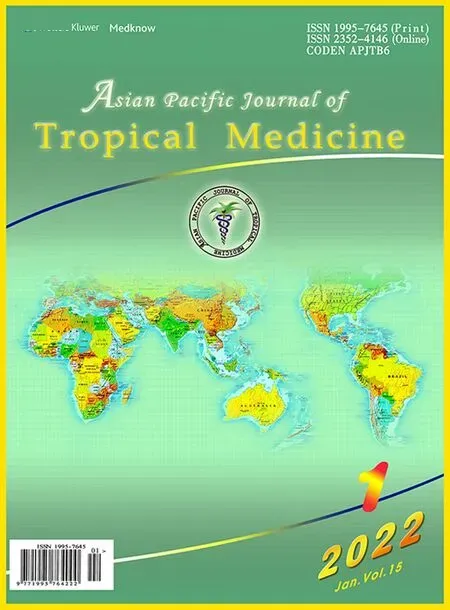Disease progression after discontinuation of corticosteroid treatment in a COVID-19 patient with ARDS
Lam Nguyen-Ho
1Department of Internal Medicine, University of Medicine and Pharmacy at Ho Chi Minh City, Vietnam
2University Medical Center HCMC, Ho Chi Minh City, Vietnam
Excessive acute inflammatory response in coronavirus-induced disease 2019 (COVID-19) patients results in multiple organ injury,especially acute respiratory distress syndrome (ARDS), contributing to a high mortality of the disease[1,2]. More evidence showed that corticosteroid, an immunomodulatory agent, reduces both the need of invasive mechanical ventilation and lowers the mortality of severe COVID-19 patients. However, its optimal dose and therapeutic duration is still ambiguous. The RECOVERY trial revealed that using corticosteroid up to 10 days reduced the mortality of hospitalized COVID-19 patients[3] and a finding also upheld by a meta-analysis by Cano et al.[4]. To the best of our knowledge, currently, there is no study evaluating disease progression after discontinuation of corticosteroid treatment in COVID-19 patients with ARDS.
A 61-year-old female patient with past history of atrial fibrillation and prosthetic bicuspid valve presented with a one-week history of fever, cough and fatigue. Her real-time polymerase chain reaction test for SARS-COV-2 was positive and peripheral capillary oxygen saturation was 89% with 15 L/min of oxygen via reservoir mask. Chest X-ray showed bilateral diffuse infiltration,predominantly in the lower half fields (Figure 1A). She was treated with oxygen via high flow nasal cannula, ceftriaxone, moxifloxacin,remdesivir, unfractionated heparin, and methylprednisolone (80 mg/day) according to the national guideline. On the sixth hospitalized day, her respiratory failure worsened with right pneumothorax requiring endotracheal intubation and chest drainage (Figure 1B).On the eleventh hospitalized day, the removal of both the chest tube and the endotracheal tube was undertaken (Figure 1C) and the supplementation of oxygen via high flow nasal cannula (flow 50 L/min and FiO2: 40%) was indicated with the result of PaO2/FiO2232. Methylprednisolone was stopped after the 10-day course of treatment. However, four days after discontinuing corticosteroid, her respiratory condition aggravated with a higher demand of oxygen(PaO2/FiO296) and progressive parenchymal infiltration on chest X-ray (Figure 1D). Follow-up of inflammatory biomarkers showed a high inflammatory response on the fifteenth hospitalized day and restarting methylprednisolone was indicated and her condition improved spectacularly (Figure 1E and 1F).

Figure 1. Chest X-ray images and changes of inflammatory biomarkers and PaO2/FiO2 in a 61-year-old female patient with COVID-19. A: Chest X-ray on the first hospitalized day shows bilateral diffuse infiltrates. B: Chest X-ray on the sixth hospitalized day shows right pneumothorax with visceral pleura (red arrows) and the endotracheal tube (red asterisk). C: Chest X-ray on the eleventh hospitalized day shows lessened the improvement parenchymal infiltration (black asterisks). D: Chest X-ray on the fifteenth hospitalized day after stopping corticosteroid shows the progression of parenchymal infiltration (black asterisks).E: Chest X-ray on the twentieth hospitalized day shows abated parenchymal infiltration again upon resumption of corticosteroid therapy (black asterisks). F:Changes of inflammatory biomarkers and PaO2/FiO2. CRP: C-reactive protein; IL-6: interleukin-6; NLR: neutrophil to lymphocyte ratio; PaO2/FiO2: partial pressure of oxygen/fraction of inspired oxygen; D1, D6, D11, D15, and D20: the first, sixth, eleventh, fifteenth, and twentieth hospitalized day, respectively.
Prolonged corticosteroid (methylprednisolone) treatment is recommended in ARDS to prevent a reconstituted inflammatory response[5]. Therefore, evaluation of inflammatory response after discontinuing corticosteroid in COVID-19 patients with ARDS should be considered. Besides, several previous case reports showed that prolonged corticosteroid treatment can be more beneficial, especially in post-acute COVID-19 patients with residual radiological changes and persistent dyspnea[6]. Further studies on this topic are required to provide more knowledge relating to specific therapeutic duration of corticosteroid and personalized therapy effectively.
Conflict of interest statement
The author declares that there is no conflict of interest.
Ethical approval and informed consent
Informed consent was obtained from the patient for the publication of this case report and any accompanying images.
Acknowledgement
The author thanks the patient to give permission to publish this letter.
 Asian Pacific Journal of Tropical Medicine2022年1期
Asian Pacific Journal of Tropical Medicine2022年1期
- Asian Pacific Journal of Tropical Medicine的其它文章
- Endophthalmitis caused by Bacteroides fragilis after pars plana vitrectomy and treatment approach
- An immunoglobulin Y that specifically binds to an in silico-predicted unique epitope of Zika virus non-structural 1 antigen
- Liposomes as immunological adjuvants and delivery systems in the development of tuberculosis vaccine: A review
- Plasmodium cynomolgi: An emerging threat of zoonotic malaria species in Malaysia?
- SARS-CoV-2 variants: A continuing threat to global health
